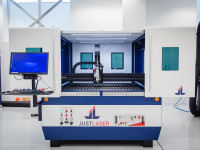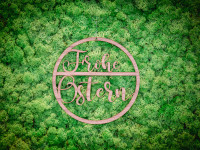Precisely process plywood with a laser cutter
Simple application and excellent results
Plywood, a versatile and widely used material in the manufacturing and design industry, provides an excellent base for a wide variety of projects thanks to its layered structure and stability.
The use of a laser cutter for processing plywood revolutionizes the possibilities in material processing and enables unprecedented precision and variety in the realization of designs.
Advantages of processing plywood with a laser cutter
Laser cutting offers several advantages over traditional processing methods, especially with a material such as plywood:
- Precision: Laser cutters enable extremely precise cuts that are difficult to achieve with manual tools.
- Versatility: From complex cuts to fine engravings, laser cutters can be used for a wide range of design requirements that would be difficult or impossible with other tools.
- Clean edges: In contrast to sawing or milling, laser cutting leaves clean, burr-free edges.
- Contactless cutting: As the laser does not physically touch the material, material stresses and deformations are avoided.
In addition, the laser cutter enables fast and efficient production of several identical parts, which can be an important time and cost factor when producing large quantities. The ability to create engravings on plywood also opens up a wide range of creative design options for different applications. Whether for model making, for furniture or as promotional gifts - laser-cut plywood offers numerous application possibilities and always presents itself with high quality and precision.
Choosing the right plywood for laser cutting
In order to be able to process plywood precisely with a laser cutter, it is important to select the right material. There are several factors to consider here, such as the thickness of the wood or its texture.
Plywood with a uniform structure and without major unevenness is best suited for laser cutting. Choose high-quality plywood that is especially suitable for laser cutting to avoid inhomogeneities and undesirable reactions such as excessive burning. At JustLaser, we rely here on the material from our partner https://wood4pros.com/
Be sure to also consider the thickness of the plywood with regard to the performance of your laser cutter. It is also advisable to carry out a few test runs in advance to ensure that the selected material is suitable for the planned cut or engraving.
Preparation of the material and the laser cutter
To process plywood precisely with a laser cutter, careful preparation of the material and the device is essential.
The first step is to select the right plywood that is suitable for laser cutting. It is advisable to choose thinner sheets as they are easier to process and a finer result can be achieved. Before the actual cut is made, the wood should be thoroughly cleaned and any dust removed.
The laser cutter itself must also be prepared by adjusting the settings such as speed and power accordingly:
- Laser focus: Ensure that the laser is correctly focused to ensure precise and clean cuts.
- Power and speed: Adjust the laser parameters to the thickness and properties of the plywood. Too high a power or too low a speed can lead to burn marks.
- Air assist: Use the air assist function on your laser cutter to blow away smoke and particles during cutting and ensure clean cuts.
Options for finishing laser-cut plywood
One of the most exciting options for finishing laser-cut plywood is undoubtedly varnishing. Here you can choose between different colors and paint textures to design the wood exactly according to your own ideas.
Whether glossy or matt, the choice of varnish also depends on the type of plywood. For example, a colorless clear lacquer is particularly suitable for birch plywood, while a dark lacquer can bring out the grain of walnut plywood even better.
However, other finishing options such as staining or oiling are also conceivable and open up unlimited creative scope for design. However, the decision for a particular type of finish should always be made in accordance with the planned area of application of the workpiece.
Post-processing
After laser cutting plywood, there are several options for post-processing to improve the final result. One option is to sand the edges to remove any remaining smoke or resin. This can help the plywood look smoother and cleaner. Another option is to clean the plywood to remove any residue and bring out the natural beauty of the material. Gentle cleaning can help ensure that the plywood is presented in its best condition.
Creative possibilities with laser cutting and plywood
It is undeniable that using a laser cutter for processing plywood offers many advantages: Speed, precision and creativity are just a few of them. By selecting the right plywood and carefully preparing the material and the laser cutter, precise cuts can be made that also allow engravings to be made on the material.
The possibilities for finishing laser-cut plywood are diverse and allow you to give free rein to your creativity. However, it is always important to observe safety precautions when using a laser cutter. In summary, the use of a laser cutter in woodworking can open up creative possibilities and deliver precise results - give it a try!



